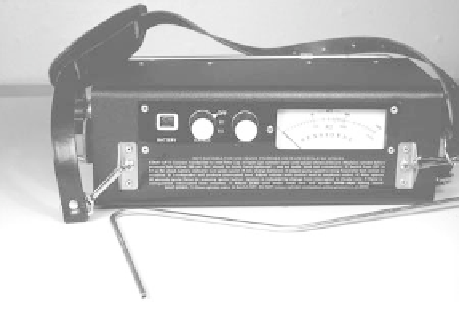Environmental Engineering Reference
In-Depth Information
NIOSH bubbler-chromotropic acid method. Depending on the range
selected, it can measure HCHO levels as low as 0.002 ppmv and as high as
10 ppmv. Analytical instruments are expensive and relatively laborious to
calibrate, set up, and clean.
4.
Volatile organic compounds
Different approaches are used to sample or monitor VOCs, depending on
aspects of their measurement and expression desired. In most buildings,
levels of individual VOCs are very low (in the low ppbv range) and so cannot
be monitored by direct-read electronic devices. An exception is methane,
which is associated with sewer gas or heating and cooking gas leaks. Meth-
ane levels can be measured using portable flame ionization detectors (FIDs)
(
Figure 9.6
).
VOCs can be sampled and expressed as concentrations of individual
substances present or as TVOC concentrations. Similar sampling procedures
are used in both cases. In practice, TVOCs are collected on solid sorbent
media using dynamic (and occasionally passive) sampling or by using evac-
uated metallic canisters. In the former case, air is drawn through a glass
sampling tube which contains one or more sorbents such as charcoal, tenax,
XAD-2, Poropak Q, etc. Sorbent media vary widely in their ability to capture
and retain specific VOCs; as a consequence, all have collection limitations.
Multisorbent samplers have been developed for VOC sampling in indoor
environments. They have the advantage of collecting VOCs over a broad
range of volatilities with relatively high accuracy and precision using low
sampling volumes.
VOCs can also be collected using evacuated metallic canisters. Canisters
have several advantages over sorption methods. These include avoidance of
chemical reactions on the sorbent and lower recoveries due to breakthrough
or incomplete desorption from sampling media. As a result, a wide range
Figure 9.6
Portable flame ionization detector.

